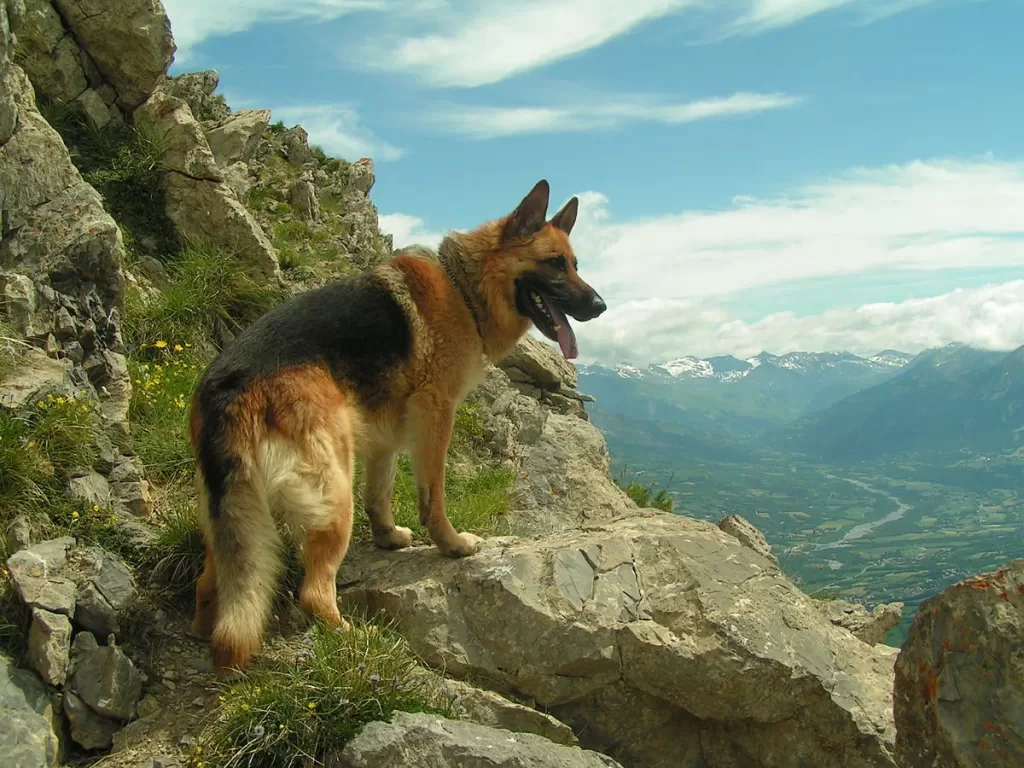Decoding German Shepherd Tail: What’s the Buzz About? Ever wondered why your dog’s tail is a big deal? Turns out, it’s their way of talking to you! German Shepherds have 13 tail positions that act like a wagging language, giving you a sneak peek into your pup’s thoughts and feelings. In the sections below, we’ll unravel the mystery behind each tail position, making it easy for pet parents to understand what’s going on in their furry friend’s mind.
Table of Contents
The German Shepherd Dog has a well-groomed, natural appearance.
The correct tail is slightly longer than the height at the withers and it should be thick and tapering. It rests low and is never curled over the back nor excitedly switching side to side.
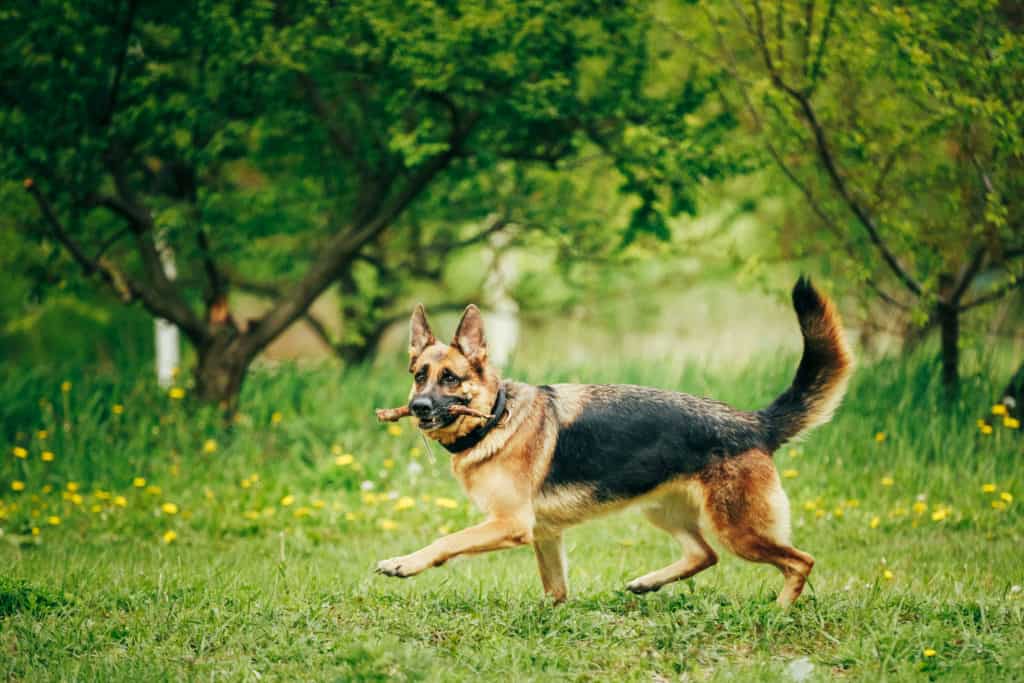
The tail is carried low and straightened, but never tightly curled over the back, more like a plume than a buggy whip.
Also Read: Happy Tail Syndrome in Dogs
A dog with a correctly functioning tail will hold it straight out or to the side when he is working or moving and will curl it between his legs when he is nervous or unsure of himself.
German shepherd tail length
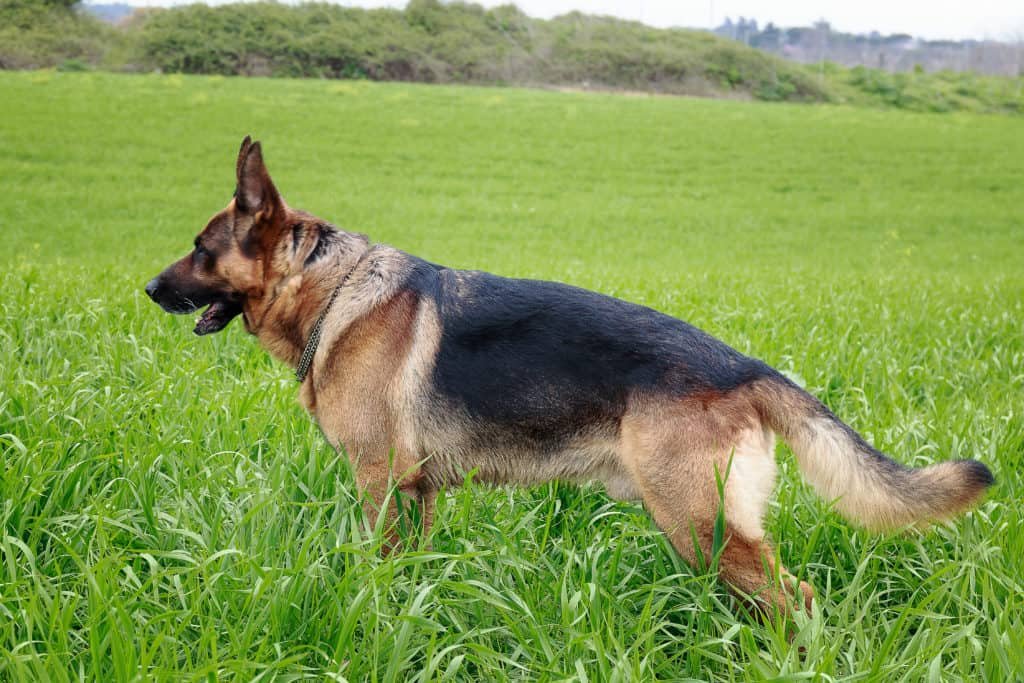
GSDs tail length is not too short, or too long. It’s supposed to be between 9 and 14 inches. This doesn’t mean that if your dog’s tail length falls outside of this range, it is deformed or has genetic problems.
A standard GSD tail length should be long enough that the tail end should reach the hock joint. It should be hanging with a slight curve like a cavalry sword when GSD is at rest.
The curve should be emphasized, and the tail should be raised when the dog is moving.
Sometimes, along with the breed traits, you’ll encounter GSDs that have tails of different lengths. A short GSD tail can grow long but will never become as long as an average GSD tail.
On the other hand, long tails can become shorter, but they’ll never become as short as an average GSD tail.
German Shepherd Tail Types and their Meaning: 13 signs and their inner behavior explanation
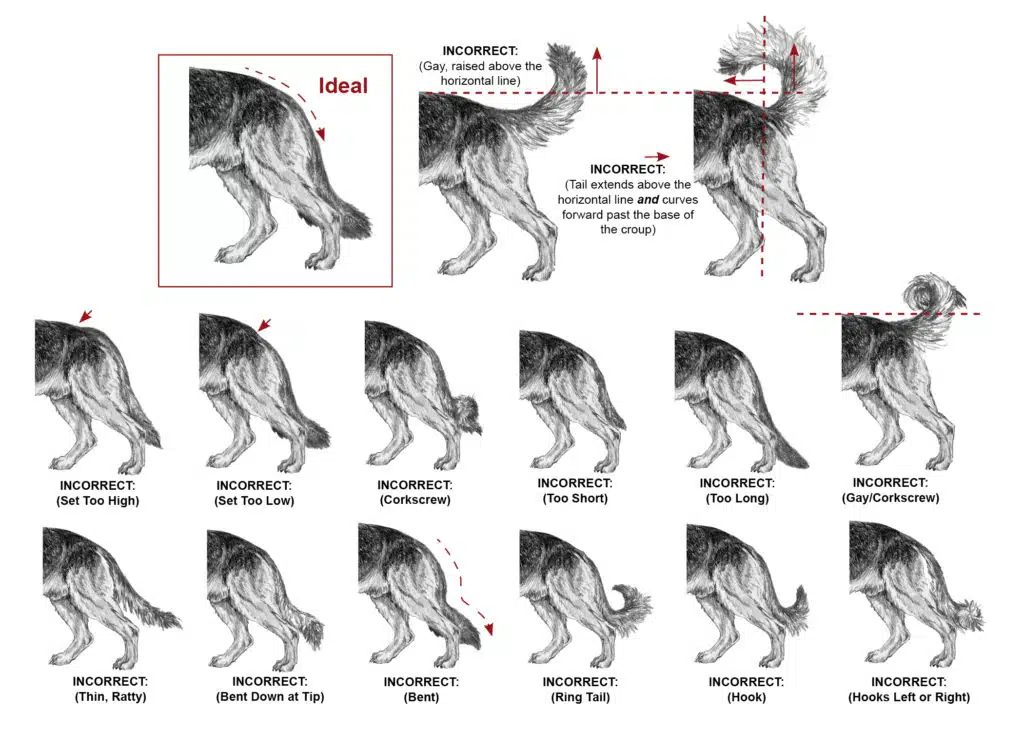
| Tail Position | Meaning |
|---|---|
| Raised high and curved over the back | This can indicate uncertainty or a cautious approach. The dog may be assessing the situation or feeling uncertain. |
| Horizontal and straight | Indicates a neutral or relaxed state. It shows that the dog is calm and content. |
| Slightly raised and wagging | A confident and alert posture, is often seen when the dog is excited, confident, or on high alert. |
| Low and tucked between hind legs | Indicates fear, anxiety, or submission. The dog may feel threatened or uncomfortable in its current environment. |
| Slow wagging | Can indicate uncertainty or a cautious approach. The dog may be assessing the situation or feeling uncertain. |
| Rapid wagging | Shows excitement and happiness. The dog may be thrilled or anticipating something enjoyable. |
| Stiff and straight up | A sign of alertness and heightened awareness. The dog may be assessing potential threats in its surroundings. |
| The tail held to one side | Can indicate indecision or curiosity. The dog may be observing or evaluating something of interest. |
| Tail held straight down | Usually a sign of relaxation or calmness. The dog may be in a neutral state or feeling at ease. |
| Tail held loosely and relaxed | Generally indicates a relaxed and comfortable state. The dog is at ease and not currently on high alert. |
| Tail wagging in a circle | An extremely happy and enthusiastic expression. The dog may be showing great joy and excitement. |
| Tail vibrating or quivering | Typically a sign of high arousal, intense excitement, or anticipation. The dog may be highly stimulated. |
| Tail held high and wagging | Indicates a friendly and confident demeanor. The dog is likely happy and open to social interaction. |
| Tail tucked and wagging | Can be a conflicting or mixed signal. It may suggest submission or fear, combined with a desire to appease or seek reassurance. |
It’s important to remember that tail positions are just one aspect of a dog’s overall body language, and it’s crucial to consider other body signals, such as facial expressions and posture, to fully understand a German Shepherd’s behavior and emotional state.
German shepherd tail problems and diseases
GSD tails are not the only measure of their current sensibilities. Because it is genetically predisposed, it can also be preyed upon by many health-related problems.
- Anal Furunculosis
Chronic inflammatory disease of the skin under the tail and around the anus, which is usually caused by an inefficient response of the immune system and genetics. But how GSDs carry their tail and thick coat around the anus is somewhat responsible. To prevent such a disease, fertility should only be between non-affected GSDs.
- Skin infection
GSD is very difficult to treat for skin diseases on the tail. The tails usually do not have that much skin, so this area is prone to infection.
German Shepherd Hair loss is caused by allergies to the tail, itching, and chewing, which can eventually lead to infection if left untreated. Incisions and scratches or even a dog bite on the tail are all causes of infection.
Topical antibiotics look lovely for GSDs as they keep their wounds smiling. Oral antibiotics that provide the right dose are the best choice.
- Limber Tail Syndrome
Limbtail Syndrome is also known as Acute Caudal Myopathy, Cold Tail, and Broken Tail. This is usually due to overwork, injuries, or spending too much time playing in cold water.
The tail muscles become swollen and painful within 24 hours after exposure to freezing cold water. Chronic confinement in narrow spaces can also trigger this syndrome.
The prognosis for the limber tail syndrome is good because it goes away on its own. Using a warm compress can reduce swelling and pain, but some veterinarians may prescribe painkillers.
Why do German Shepherds Chase Their Tail?
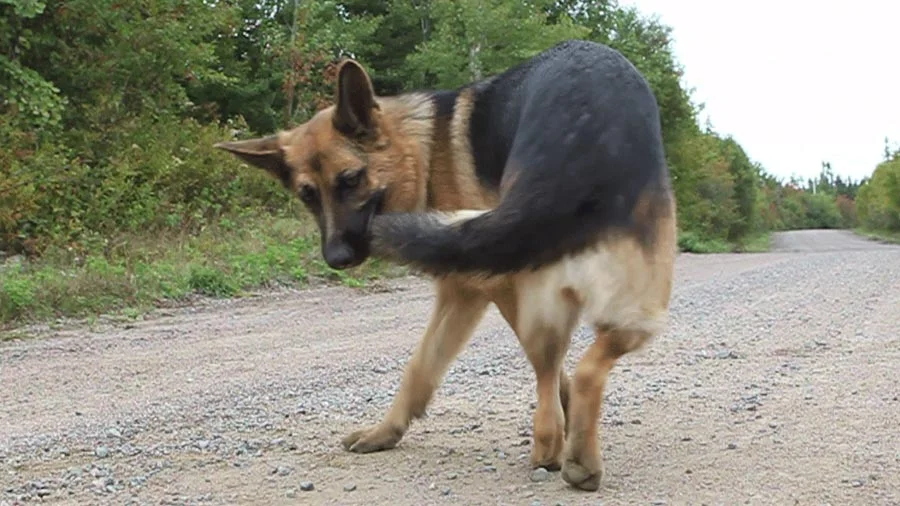
Puppies or adult dogs chasing their tails can be fun. They try to catch their tails and scream when they catch it. GSD is one of the many dog breeds exposed to obsessive tail chasing. Many factors contribute to this behavior.
By simply analyzing the causes, employers can train their GSD to stop this behavior. Training them as a puppy is a good start. In adult GSDs, distraction can help.
- GSDs are large dogs so keeping them in a narrow space can cause them anxiety, causing the tail to chase.
- Due to lack of exercise and activity they chase their tails in circles and sometimes eight widths. Giving them activities and making them “work” or exercise will reduce their boredom.
- Genetics may also be responsible for this behavior. This behavior may have been passed down to them by their parents.
- Stress and anxiety cause them to chase their tail until they injure themselves. So it is important to check for stress and anxiety triggers.
Do German shepherds have curly tails?
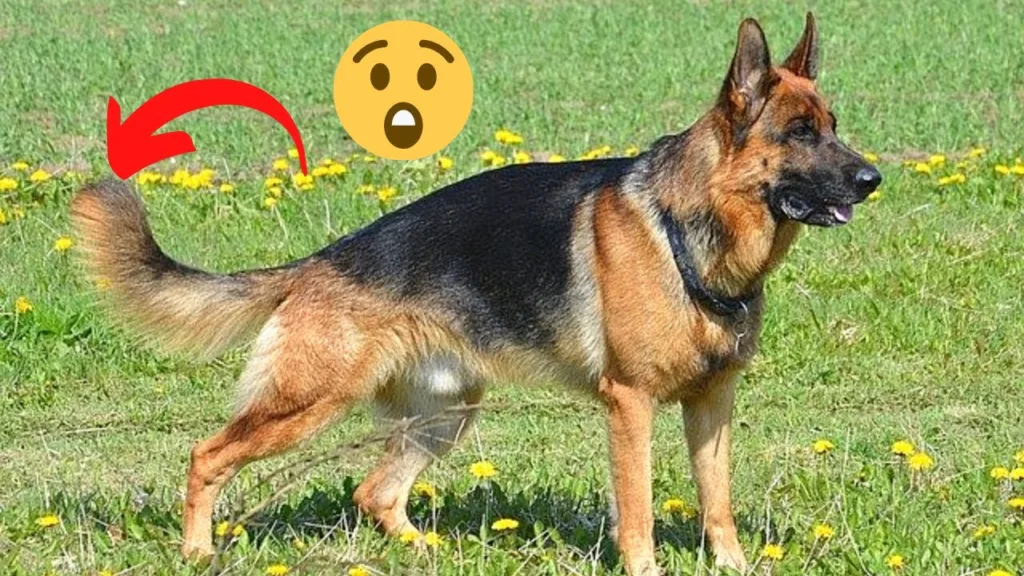
Do German shepherds have curly tails? The short answer is yes, it is possible for GSDs to have curly tails. However, the fact that not all GSDs have curly tails leads to the question of whether or not German shepherds are capable of producing curly tails.
A German Shepherd may have a tightly wound tail that wraps over the backside. It’s not that uncommon for GSDs to have tails that curl over the back, but it is usually a fault seen in other breeds. You can check out the official standard here.
Why does a German shepherd’s tail curl?
Curls are born, not made, so if your dog’s tail normally curls by nature, it could be a sign of mixed breeding. While the curl doesn’t always indicate cross-breeding, it can sometimes be indicative of genetic material from another breed.
When do German shepherd’s tails get bushy?

When do German shepherds’ tails get bushy? The normal German shepherd could take somewhere between 18 to 36 months to complete their growth and become fully mature.
The tail will continue to develop until the animal is two years old. However, the tail will start to change in appearance at around eight weeks.
FAQs on German Shepherd Tail Positions
Can tail positions in German Shepherds be a reliable indicator of their emotions?
A gentle wag indicates a reserved and tentative greeting.
An expansive, wide wag signifies a friendly and joyous demeanor.
A unhurried wag with a lowered tail suggests feelings of insecurity.
A quick, small wag might signal the dog’s readiness for energetic activities like running or play-fighting.
What does it mean when a German Shepherd’s tail is wagging rapidly?
When a German Shepherd’s tail is wagging rapidly, it typically indicates excitement and happiness. The dog may be thrilled or anticipating something enjoyable, such as playtime or seeing a familiar person.
Rapid tail wagging is often a positive expression of the dog’s emotions and can be seen as an invitation for interaction or a sign of joy.
What does it mean when a German Shepherd’s tail is wagging slowly?
When a German Shepherd’s tail is wagging slowly, it can indicate uncertainty or a cautious approach. The dog may be assessing the situation or feeling unsure about how to respond.
Slow tail wagging is often associated with a more reserved or tentative emotional state, where the dog may be evaluating the environment or displaying a milder form of engagement compared to rapid wagging.
Why is the bushy tail important for the German Shepherd Dog breed?
As the American Society for the Prevention of Cruelty to Animals (ASPCA) points out, the bushy tail is one of the most widely recognized features of GSDs.
The tail is so important that the German Shepherd, registered with the American Kennel Club (AKC), appears prominently on the official breed standard (performance and confirmation guidelines).
The official breed standard for GSD says what a German Shepherd’s dog tail looks like in adulthood. Here are the main points described in the racial standard:
- The tail should be bushy.
- The tail should extend to the hawk joint (kept away from the body parallel to the ankle joint).
- The tail should hang slightly curved “like a saber”.
- The tail should not be short or docked (cut).
Dog owners who want to show off their German shepherd at dog shows or confirmation competitions run the risk of being disqualified or points deducted if they do not meet each performance guideline of their dog breed standard.

